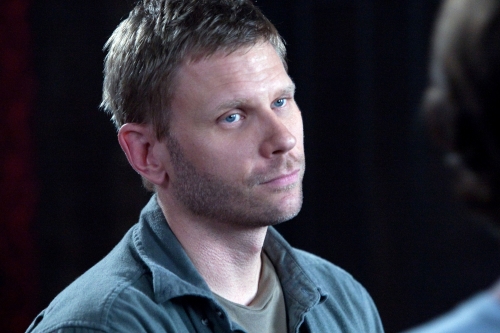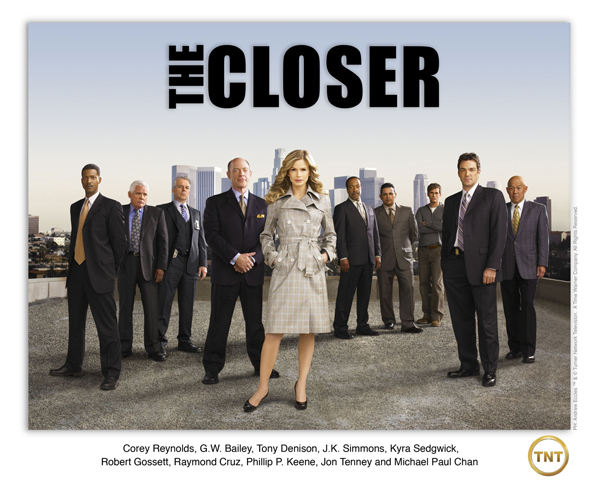Note: I use the term queer as an umbrella term for all sexual and gender minorities with an acknowledgment that queer is a historically pejorative term.
SPOILER ALERT! This article includes spoilers for Season 7 of TNT’s The Closer.
 |
| The cast of The Closer |
As The Closer’s Chief Brenda Leigh Johnson (Kyra Sedgwick), a tough Southern Belle from Georgia, returns to LAPD headquarters this coming July, she will be joined, again, by new and popular recurring character Gavin Q. Baker III (Mark Pellegrino), a lawyer Johnson hired after falling into legal trouble over the murder of a gang member in her custody. The Hollywood Reporter describes Gavin as a “gay, former city attorney-turned-partner in a private law firm.” Pellegrino, known for his work on Being Human, Lost, and Supernatural offers a skillful portrayal of the intelligent yet arrogant lawyer, which fans have positively reviewed.
 |
| Mark Pelligrino |
The Closer Creator, James Duff, has been a vocal advocate for LGBT representation on television. At a Power Up dinner in which he was honored, Duff had the following words to say:
I know how hard it is to get stories about gay people, lesbians, and transgender and bisexual people on the screen, and people need to see these stories. Not just young gay people, not just young people in the LGBT community but straight people need to see these stories too. They need to know—they need to know that we are a part of America.
According to GLAAD’s Where We Are On TV 2011-2012 Report an annual report about diversity on television, there are 28 LGBT series regulars on mainstream cable and 26 recurring characters. GLAAD credits TNT with three LGBT characters with The Closer having one recurring character: Dr. Morales played by Latino gay male Jonathon Del Arco. Despite its low visibility count, several producers and actors of the series support LGBT rights.
The Closer began with a definitive statement in the pilot episode in which a lesbian living as man is murdered by her unsuspecting girlfriend. The writers frame homophobia as a negative attribute and position Brenda as a supporter of LGBT equality. Throughout its seven seasons, the series has included gay characters, gay actors, and gay-themed storylines that include issues of homophobia, anti-gay violence, and gay activism.
The cast created a PSA about GLSEN’s Safe Space Campaign in response to the high number of gay teen suicides. Prominent gay male actors like Peter Paige (Queer as Folk) and The Closer’s own Phillip. P. Keane who portrays Buzz Watson (character’s sexuality is unknown) appear in the series. Most importantly, The Closer Creator, James Duff, is gay. The last fact makes Gavin’s introduction all the more interesting.
Despite being likeable, Gavin is a problematic character. Because Gavin has never verbalized his sexuality, viewers must rely on clues to decipher his sexual orientation. This is not a difficult task because the series gives quite obvious (and stereotypical) markers of Gavin’s sexuality.
Since the writers do not have Gavin specifically state that he is gay, the question becomes, how do we as viewers understand Gavin as a gay man? Dr. Morales speaks of his boyfriend on several occasions, but Gavin is more of a mystery. How do we know that he is, in fact, gay at all? If one did not read news stories about Pellegrino joining the cast and the introduction of his character, how would we even know? Do we all know a gay person when we see one? Of course not. We may think we do, but really we don’t. More often than not we draw these conclusions based on assumptions that derive from stereotypes about gay people and gender assumptions.
When I say that we rely on stereotypes I mean that we associate certain behaviors, attributes, and characteristics with different genders, like women like to shop and men like their tools (very simplistic, I know). Women and men act (or perform) their gender through how they dress, how they walk, how they converse with others, and so on. These gendered ways of living become expectations for those in the gender group and lead to assumptions about those who present as one gender or another. For lesbians and gay men, the assumptions are reversed. For example, one assumption—albeit a stereotype—about gay men is that they’re feminine. Because we rely on stereotypes to inform our opinions of others, especially groups in which we do not belong, we begin to expect members of this group to behave in the way we assume.
For television and film, we rely on writers to tell us who these people are, and we rely on actors to embody them and to make their experiences believable and relatable. As socialized creatures in an increasingly visual culture we have learned how to read people and to read characters. It’s become second nature that we don’t even realize we’re doing it. We learn at a young age how to differentiate between genders, races, and ages. Granted, this is becoming increasingly more difficult and complicated, but we still do it.
 |
| Gavin |
Viewers first meet Gavin in the episode “Home Improvement” when Brenda and her husband, Fritz, meet him for a consultation. Gavin presents as a confident, no-nonsense lawyer with a great knack for interior office design (see hand sculpture). His charm and wit are as attractive as his tailored suits. Pellegrino provides the character with deliberate hand gestures and feminine mannerisms along with a slow and snarky speech pattern.
Thus far, Gavin performs stereotypical gay male cues that are so recognizable that they’ve become cliché. It’s almost like they’re saying “We don’t need to tell you that he’s gay because it’s written all over him!”
After a tense yet humorous exchange among the characters about Gavin’s $10/minute fee and $25,000 retainer, Brenda and Fritz rush out of the office with Brenda angrily quipping to Fritz, “Gavin Q. Baker. The “Q” stands for quick!” Although I usually like double entendres, this one is quite puzzling because of its potentially derogatory insinuation. (“Q” as in “quick” OR “Q” as in “queer?”)
Interestingly, there is a concerted effort to physically create this character. Greg La Voi, the series’ costume designer describes, in detail, on his Fashion File blog the inspirations for Gavin’s attire and accessories, such as his signature brooches, diamond pinky rings, and fashionable scarves (as suggested by Duff). La Voi does put a significant amount of work in each of The Closer characters, but Gavin is of particular interest here in that his dress marks a sense of femininity.
As much as I like Gavin I can’t help but be critical of this portrayal. My skepticism about the progressive nature of this character grew larger after the episode “Star Turn” in which a popular teen idol’s (obviously inspired by Miley Cyrus) father dies. The teen pop star’s hit song “Daddy, Say Yes” rises in the charts after her father’s death. Gavin stops by Brenda’s precinct for a visit and fawns over the case:
Gavin: Oh, wait, wait, wait. You’re still working on that case? [singing] Daddy, say yes!
Brenda: Yes.
Gavin: [excitedly] Oh my God. Is that not the worst video ever? I’ve watched it fifty times.
Sigh. A gay man giddy over a teen pop star is so stereotypical that I don’t even know why they did it.
Let’s recap, how do we know Gavin is gay? He uses feminine hand gestures. Check. Sometimes he wears traditionally feminine accessories. Check. He likes teen pop stars. Check. Said that he’s gay? Don’t recall. If a gay man equals an effeminate man than how are we progressing in our understandings of gender and sexuality? This is not to say that effeminate gay men do not exist or that effeminate gay men on screen (and in real life should) “tone it down.” What I am essentially critiquing are associations: the automatic association between gender performance and sexual orientation.
Maybe we’ve evolved as viewers. Do we not need clues anymore? Maybe LGBT people have been fully accepted into U.S. society? Are big announcements such as Ellen DeGeneres’ no longer necessary? On the other hand, are small clues enough? Is it possible to be too subtle?
We all want to come to a place in which a person’s sexual orientation (and gender, race, class, nationality, age, ability, etc.), does not determine their status in society. However, what clues have we grown comfortable with that might actually prevent us from reaching our goal?
Those in the dominant group are often comfortable with these types of characters because they fit the box. We like the box. The box is our safe place. We know what is in the box and the box does not talk back. But when marginalized group members do not fit, we question their authenticity (e.g. “You don’t look gay? Are you sure you’re gay?”). What if a gay person doesn’t fall into a stereotype and never discloses? What do you do then as a viewer? Assume they’re straight? Hold assumptions?
Nevertheless, this characterization is compelling considering that Duff is gay and strongly advocates for LGBT visibility. Why would Duff introduce a character like Gavin that reinforces preconceived notions about gay men? This reminds me of the brouhaha about Will & Grace’s Jack McFarland, a character heavily criticized for his flamboyancy, but interestingly, portrayed by gay male actor, Sean Hayes. Some gay men might be annoyed with yet another feminine-performing gay male on television while others may find empowerment and positive visibility in a character like Gavin. Who knows! Representations of marginalized groups are always a double-edged sword. Everyone wants to be depicted “accurately” and without prejudice or stereotypes, yet when attempts are made, there’s still criticism (like this article).
I began this essay with a strong criticism of Duff’s decision to create this character, but now I am actually quite intrigued about the possibility of queer characters on television that never say they’re queer.
As the final 6 episodes of the series premieres in July, we will see more of Gavin as Brenda’s legal troubles continue. I wait with excitement to see how The Closer says goodbye to its lovely gay lawyer.
———-
